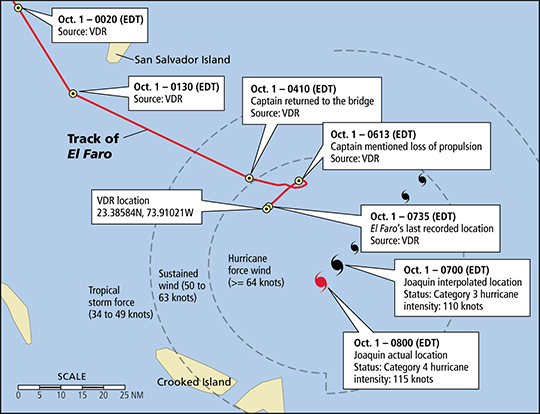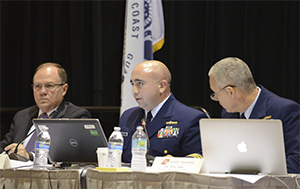The U.S. Coast Guard’s report on the El Faro disaster identified key failings by Capt. Michael Davidson and ship operator TOTE Maritime, as well as shortcomings in the Coast Guard’s oversight of third-party inspections.
The agency released its Marine Board of Investigation report on Oct. 1, two years after the 791-foot cargo ship lost power during Hurricane Joaquin and sank near the Bahamas. All 28 U.S. sailors and five Polish technicians on board died.
The 199-page report states that the ship’s proximity to the hurricane was the underlying cause of the accident. It also says flooding within the ship, combined with strong winds and battering waves, caused the vessel to roll over and sink while sailing from Jacksonville, Fla., to San Juan, Puerto Rico.
Coast Guard investigators said Davidson never grasped the seriousness of the flooding, and responded with insufficient urgency after the vessel lost its main engine less than two hours before it sank. Had Davidson survived, the Coast Guard said, it would have charged him with negligence.
Davidson “was ultimately responsible for the vessel, the crew and its safe navigation,” Capt. Jason Neubauer, chairman of the Marine Board of Investigation, said during an Oct. 1 news conference in Jacksonville. “The master misjudged the path of Hurricane Joaquin and overestimated the vessel’s heavy-weather survivability.”
TOTE faces civil penalties stemming from the inquiry related to crew rest violations during an earlier trip and failure to notify the Coast Guard about vessel repairs before the accident voyage. The report describes crew training gaps and El Faro crewmembers’ apparent unfamiliarity with crucial mechanical systems.
 |
|
The lifeboats on El Faro were similar to those on sister ship El Yunque, shown undergoing an NTSB examination in Jacksonville, Fla., eight days after El Faro sank. |
|
Courtesy NTSB |
The document lists nearly 40 safety and administrative recommendations, including requiring high-water alarms, eliminating open lifeboats and requiring closed-circuit cameras in cargo holds and other unmanned spaces. Another recommendation suggests closer scrutiny of hull openings as potential sources of downflooding.
The Marine Board of Investigation held three rounds of hearings with dozens of witnesses to gather information about El Faro, TOTE Maritime and the factors related to the accident. The recovery of the ship’s voyage data recorder (VDR) almost three miles below the surface provided critical information about the incident. The National Transportation Safety Board (NTSB), which released the VDR transcript last year, will present its own findings in December.
Until then, the Coast Guard’s report is the first and only official account of what happened to the 41-year-old ship and the people on board. Although the report does not specify the initial source of flooding, it suggests El Faro began taking on water in one or more cargo holds at about 0130 on Oct 1. At that time, the vessel changed course and wind heel pushed the second deck closer to the waterline.
Whatever the source, seawater ultimately reached cargo hold No. 3 through an open scuttle and possibly from deterioration of internal watertight components, the Coast Guard determined. Investigators could not identify how the scuttle opened, but based on the amount of water in hold No. 3, it likely went undetected for some time in multiple holds.
Later that morning, at about 0554, Davidson induced a port list to let the chief mate close the scuttle. The Coast Guard said the port list was greater than the previous starboard list, contributing to loss of lube oil suction, which caused the main engine to fail at about 0600. However, the report notes El Faro departed Jacksonville on its final voyage with lower-than-recommended lube oil levels.
As El Faro’s list became more severe, Coast Guard investigators believe its ventilation trunks became periodically submerged, allowing seawater to pour into the ship’s watertight spaces. The severe list caused by free surface effect in the flooded hull, combined with hurricane-force winds and large waves, “would have inevitably resulted in the capsizing of the vessel,” the report said.
 |
|
A diagram released by the National Transportation Safety Board shows El Faro’s route in the Caribbean on Oct. 1, 2015, and key data points as the ship confronted a strengthening Hurricane Joaquin. |
|
Pat Rossi illustration/NTSB |
El Faro’s superstructure likely separated from the hull after the vessel sank. The report suggests a “thermal event” occurred when cold seawater contacted extremely hot boiler equipment, causing a “thermal pressure wave” radiating upward into the superstructure. Hull damage, including crumpled plating at the stern, likely occurred when El Faro hit the ocean floor at up to 50 mph.
During the investigation, the Coast Guard determined El Faro’s crew and the five Polish technicians on board lacked training to survive an “abandon-ship scenario.” It also concluded the crew wasn’t familiar enough with the ship to determine the source of flooding or properly respond to it. Given the ship’s heavy list, the vessel’s open lifeboats were deemed inaccessible.
“The crew’s complacency, lack of training and procedures, and El Faro’s design contributed to the crew’s failure to assess whether the vessel’s watertight integrity was compromised,” the report said.
The Coast Guard determined TOTE and Davidson did not properly identify risks associated with sailing toward Hurricane Joaquin during El Faro’s final voyage. The report noted TOTE also provided inadequate shoreside support to the vessel and failed to provide tools for accurate weather predictions.
Davidson’s actions during the vessel’s final night at sea also were scrutinized. The Coast Guard said he did not download the latest weather predictions at 2300 on Sept. 30, or adequately respond to crew reports about the ship’s proximity to the storm. These omissions when he was off watch from 2000 to 0400 indicate he “failed to carry out his responsibilities as captain of the vessel.”
William Bennett III, an attorney representing Davidson’s widow, Theresa Davidson, said the Coast Guard report contains faulty analysis and omissions of critical facts.
“We acknowledge that a captain is responsible for the safety of his vessel, however, there are many other key factors that primarily caused the sinking of the vessel and thus we do not agree with all aspects of the USCG report,” he said in an email. “We will be submitting a detailed response to the report.”
The Coast Guard also found fault with its own processes, in particular its oversight of inspections conducted by the classification society American Bureau of Shipping (ABS).
“(The board) determined that ABS failed to meet the expected performance standards under the Alternate Compliance Program,” Neubauer said in Jacksonville, noting that the organization used “unqualified surveyors” for key inspection activities.
Neubauer added that “the failure of surveyors to identify degraded conditions in key areas aboard El Yunque, a sister vessel to El Faro, all raise concerns about ABS’ performance on behalf of the Coast Guard.” Investigators also stated that Coast Guard oversight of ABS “was lacking.” ABS did not respond to a request for comment on the findings.
TOTE Maritime, which operated El Faro through a subsidiary, faces fines stemming from civil violations found during the investigation. These include violations of rest requirements among El Faro crew on earlier voyages, failure to properly train riding crew in emergency procedures, and failure to notify the Coast Guard and ABS about boiler piping and lifeboat system repairs.
In a prepared statement, TOTE did not address the civil charges outlined in the report. Spokesman Michael Hanson said the company is “eternally sorry” for the loss of the ship and its personnel.
 |
|
Lt. Cmdr. Mike Venturella, center, questions a witness during the Coast Guard’s El Faro hearings in Jacksonville, Fla., in May 2016. He is flanked by NTSB lead investigator Tom Roth-Roffy, left, and Cmdr. Mike Odom. It was the second of three Marine Board of Investigation sessions in which 76 witnesses testified over 30 days. |
|
Courtesy U.S. Coast Guard |
“Nothing we can do will bring back the remarkable crew,” Hanson said, “but everything we do can work to ensure that those who go to sea, serving us all, are in ever-safer environments. … The report details industry practices which need change.”
Jacksonville maritime attorney Rod Sullivan believes the El Faro disaster has already spurred changes in the industry, particularly regarding vessel inspections. He said at least three ships have been scuttled as a result of tougher inspections, and five others required extensive repairs.
Sullivan, who represented the estate of crewmember Sylvester Crawford Jr. in a lawsuit against TOTE, considers the Coast Guard report thorough and clear. But he suggested more attention should have been paid to questions of survival.
“The idea that 33 people can go onto a ship and into the sea in the 21st century and nobody comes home is shocking to me,” he said.
Capt. Joseph Murphy, who retired last year from Massachusetts Maritime Academy, said the Coast Guard’s findings will have far-reaching implications for the maritime industry worldwide.
“There is an old adage, ‘The recipe for a marine disaster is old ships, bad weather and poorly trained crews,’” he said. “The El Faro incident checked every box.”

